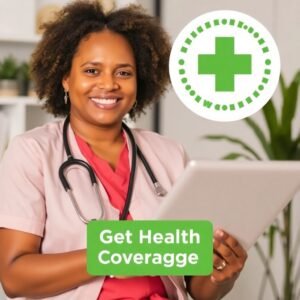Life is unpredictable, and health emergencies can strike at any time. Without proper health coverage, a simple medical issue can lead to financial strain. Whether you’re uninsured or looking for better options, the time to act is now. This guide will walk you through the steps to secure health coverage quickly and affordably.
Why You Need Health Coverage Immediately
Financial Protection
Health coverage shields you from exorbitant medical bills, ensuring you’re not financially devastated by unexpected illnesses or accidents.
Access to Preventive Care
Regular checkups, vaccinations, and screenings help catch potential health issues early, saving you time and money in the long run.
Legal Requirements
In some regions, having health insurance is mandatory, and failing to comply could result in penalties.
Peace of Mind
Knowing you’re covered in case of emergencies reduces stress and allows you to focus on other aspects of your life.
Types of Health Coverage Available
Employer-Sponsored Insurance
If you’re employed, check with your HR department for group health plans, often subsidized by your employer.
Government Programs
- Medicaid: Free or low-cost insurance for low-income individuals and families.
- CHIP: Coverage for children from low-income families.
- Medicare: Designed for individuals aged 65 and older or those with certain disabilities.
ACA Marketplace Plans
Affordable Care Act (ACA) marketplace plans offer coverage options with income-based subsidies to reduce costs.
Short-Term Health Plans
Temporary coverage for those between jobs or waiting for long-term plans.
Health Sharing Programs
An alternative to traditional insurance, where members share medical costs.
Steps to Get Health Coverage Quickly
1. Assess Your Needs
Evaluate your healthcare requirements, including doctor visits, medications, and specialist care.
2. Check Eligibility for Subsidies
Determine if you qualify for government programs or income-based discounts on marketplace plans.
3. Compare Plans Online
Use trusted platforms like Healthcare.gov or private tools like eHealthInsurance to find the best options.
4. Gather Required Documents
Have your identification, proof of income, and residency documents ready to expedite the process.
5. Enroll During Open Enrollment or Qualify for Special Enrollment
- Open Enrollment Period: The designated time each year to sign up for health coverage.
- Special Enrollment Period: Triggered by qualifying events like job loss, marriage, or childbirth.
6. Contact a Licensed Insurance Agent
Agents can provide personalized advice and help you navigate complex options.
Benefits of Getting Coverage Now
Immediate Access to Care
Once enrolled, you can schedule doctor visits, fill prescriptions, and access essential medical services right away.
Protection Against Unexpected Costs
Coverage helps manage expenses for emergency room visits, surgeries, or hospital stays.
Improved Health Outcomes
Regular medical care leads to early diagnosis and better management of chronic conditions.
Common Challenges and How to Overcome Them
High Premiums
Apply for subsidies or choose high-deductible plans if you’re in good health.
Confusing Options
Use online comparison tools or consult an insurance expert to simplify the process.
Limited Networks
Verify that your preferred doctors and hospitals are in-network before choosing a plan.
Case Study: How Anna Secured Coverage in One Day
Anna, a self-employed graphic designer, realized she needed health coverage after an unexpected medical emergency. By visiting Healthcare.gov, she qualified for a silver-tier plan with a $50 monthly premium. Within hours, she was enrolled and had immediate access to care.
Here’s a table summarizing the key information about getting health coverage:
| Category | Details |
|---|---|
| Why Get Health Coverage? | – Financial Protection: Avoid costly medical bills.- Preventive Care: Access regular checkups and screenings.- Legal Compliance: Meet insurance mandates in applicable regions.- Peace of Mind: Reduce stress about unexpected health issues. |
| Types of Health Coverage | – Employer-Sponsored Insurance: Often subsidized by employers.- Government Programs: Medicaid, CHIP, Medicare.- ACA Marketplace Plans: Subsidy-eligible plans.- Short-Term Plans: Temporary coverage for transitions.- Health Sharing Programs: Alternative cost-sharing models. |
| Steps to Enroll Quickly | – Assess healthcare needs.- Check eligibility for subsidies.- Compare plans online.- Gather necessary documents.- Enroll during open or special enrollment.- Consult a licensed insurance agent if needed. |
| Benefits of Quick Enrollment | – Immediate access to care.- Protection from unexpected costs.- Better health outcomes with regular care. |
| Challenges & Solutions | – High Premiums: Apply for subsidies or choose high-deductible plans.- Confusing Options: Use online tools or consult experts.- Limited Networks: Verify in-network providers before enrolling. |
| Case Study Example | Anna’s Experience: Self-employed and uninsured, she used Healthcare.gov to find a plan for $50/month and gained immediate coverage. |
This table provides a concise overview of the topic for easy reference.
Conclusion
There’s no better time than now to get health coverage. With a wide range of options available—from government programs to private plans—you can find a solution that meets your needs and budget. Don’t wait for an emergency to remind you of its importance. Take the first step today and secure your health and financial future.
FAQs
- What’s the fastest way to get health coverage?
Enroll through the ACA marketplace during open enrollment or qualify for special enrollment due to a life event. - Can I get insurance if I’m unemployed?
Yes, government programs like Medicaid or marketplace plans with subsidies are available for low-income individuals. - What documents do I need to apply?
You’ll typically need identification, proof of income, and residency documents. - Are short-term health plans a good option?
They’re suitable for temporary needs but may not provide comprehensive coverage. - When can I enroll in health insurance?
During the annual open enrollment period or a special enrollment period triggered by qualifying life events.



